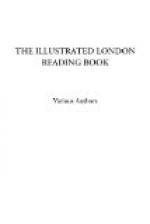Two or three mills and a few mud huts, inhabited by Turkish herdsmen, contain all the present population of Sardis.
* * * * *
MARTELLO TOWERS.
[Illustration: Letter A.]
At a time when there appeared to be good reason for believing that the invasion of England was contemplated, the Government turned their attention to the defence of such portions of the coast as seemed to present the greatest facility for the landing of a hostile force. As the Kentish coast, from East Were Bay to Dymchurch, seemed more especially exposed, a line of Martello Towers was erected between these two points, at a distance from each other of from one-quarter to three-quarters of a mile. Other towers of the same kind were erected on various parts of the coast where the shore was low, in other parts of England, but more particularly in the counties of Sussex and Suffolk. Towers of this construction appear to have been adopted, owing to the resistance that was made by the Tower of Martella, in the Island of Corsica, to the British forces under Lord Hood and General Dundas, in 1794. This tower which was built in the form of an obtruncated cone—like the body of a windmill—was situated in Martella, or Martle Bay. As it rendered the landing of the troops difficult, Commodore Linzee anchored in the bay to the westward, and there landed the troops on the evening of the 7th of February, taking possession of a height that commanded the tower. As the tower impeded the advance of the troops, it was the next day attacked from the bay by the vessels Fortitude and Juno; but after a cannonade of two hours and a half, the ships were obliged to haul off, the Fortitude having sustained considerable damage from red-hot shot discharged from the tower. The tower, after having been cannonaded from the height for two days, surrendered; rather, it would appear, from the alarm of the garrison, than from any great injury that the tower had sustained. The English, on taking possession of the fort, found that the garrison had originally consisted of thirty-three men, of whom two only were wounded, though mortally. The walls were of great thickness, and bomb-proof; and the parapet consisted of an interior lining of rush matting, filled up to the exterior of the parapet with sand. The only guns they had were two 18-pounders.
The towers erected between East Were Bay and Dymchurch (upwards of twenty) were built of brick, and were from about 35 feet to 40 feet high: the entrance to them was by a low door-way, about seven feet and a half from the ground; and admission was gained by means of a ladder, which was afterwards withdrawn into the interior. A high step of two feet led to the first floor of the tower, a room of about thirteen feet diameter, and with the walls about five feet thick. Round this room were loopholes in the walls, at such an elevation, that the men would be obliged to stand on benches in the event of their being required to oppose an attack of musketry. Those benches were also used as the sleeping-places of the garrison. On this floor there was a fire-place, and from the centre was a trap-door leading downwards to the ammunition and provision rooms. The second floor was ascended by similar means.




